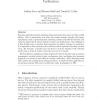Free Online Productivity Tools
i2Speak
i2Symbol
i2OCR
iTex2Img
iWeb2Print
iWeb2Shot
i2Type
iPdf2Split
iPdf2Merge
i2Bopomofo
i2Arabic
i2Style
i2Image
i2PDF
iLatex2Rtf
Sci2ools
ENTCS
2002
2002
Combining Monitors for Runtime System Verification
Runtime verification permits checking system properties that cannot be fully verified off-line. This is particularly true when the system includes complex third-party components, such as general-purpose operating systems and software libraries, and when the properties of interest include security and performance. The challenge is to find reliable ways to monitor these properties in realistic systems. In particular, it is important to have assurance that violations will be reported when they actually occur. For instance, a monitor may not detect a security violation if the violation results from a series of system events that are not in its model. We describe how combining runtime monitors for diverse features such as memory management, security-related events, performance data, and higher-level temporal properties can result in more effective runtime verification. After discussing some basic notions for combining and relating monitors, we illustrate their application in an intrusion-t...
Complex Third-party Components | ENTCS 2002 | General-purpose Operating Systems | Runtime Verification |
| Added | 18 Dec 2010 |
| Updated | 18 Dec 2010 |
| Type | Journal |
| Year | 2002 |
| Where | ENTCS |
| Authors | Joshua Levy, Hassen Saïdi, Tomás E. Uribe |
Comments (0)

